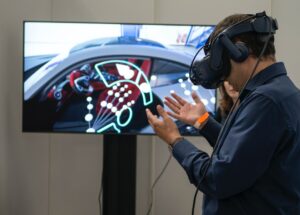We may earn money or products from the companies mentioned in this post.

Control it With your Mind
A brain computer interface, staple in sci-fi entertainment everywhere. When you think of someone controlling robots or any other technical equipment with their mind that is a fictional version of a brain computer interface. In the year 2022 we have seen a few things come to life that we only once thought were complete fantasy. We now have virtual reality technology, robot vacuums, and long-range camera drones. With all that you would think nothing would be surprising anymore but the idea of thought controlling a machine still seems like magic. Magic is what they are working to perfect however, with BCI’s
Ok, So How Do Brain Computer Interfaces Work?
Brain computer interfaces use the electrical signals your brain creates as it thinks to direct the computer to deliver specific commands for designated tasks. In order to read those signals small sensors are placed topically on the brain with a headpiece to pick up those signals. Surgical sensors called “neural” dust are in development and would greatly increase the accuracy signals it is reading but at the time of this
research, and article, non-invasive sensors are more commonly being used to develop the technology. A BCI does NOT read your mind or analyze the muscle you are moving on your head but rather just the electrical signals and translates them into something the machine can use. The user and brain computer interface work together. After some usual required training, they can focus their thought intention. For example, up or down, and then the BCI will read the appropriate electrical signals created then translate them into machine language to direct the computer.
BCI Historical points
BCI technology has been slowly built up for decades. It could roughly be said it got its starting point from Hans Berger, with the discovery of EEG or electroencephalography(say that five times fast). Basically, electrical brain signals. He created a machine with silver foils to go on a patients head and detect with an electrometer, discovering the brain did in fact, use electric signals. Later on UCLA professor Jacques Vidal coined the expression BCI in 1973 and is referred to as the creator or originator of modern brain computer interfaces. He wrote a paper depicting the challenges of BCI development and the maze of a path it could go along until maturity. Years later of course we now have actual brain computer interfaces in development learning how to control things like drones as we progress down the road further.
How Will BCI’s Be Used?
The implementation possibilities of brain computer interfaces will be enormous. Any moving machine in use today could be adjusted to be controlled by thought with the proper signal/command setup for the device. The disabled especially would get tremendous benefit from BCI’s. Imagine not being able to speak but using thought to command a computer device to deliver audio. Someone with prosthetics could simply will their legs to move much like a person with normal ligaments. This is just a few of the possibilities to aid the disabled with BCI’s.
The entertainment industry has really only recently gained traction with virtual reality. It has branched out to other uses like socializing or virtual training. If you have ever used a virtual reality headset before you would know that while the controls are manageable they still don’t feel truly immersive. Adding a brain control interface could leap the technology forward to the point of simply willing your avatar forward in the game or environment would move it along. It is exciting to imagine the possibilities of being closer to a truly virtual immersive world. As of right now though brain control interfaces are only being used and developed in a research setting. Hopefully not too far in the future we will see it start to unfold.
A Few Examples of Companies Working On BCI’s
- Neuralink – Founded by Elon Musk, this companies goal is to create a connection between the human brain and AI. This technology will help the paralyzed, people with memory loss problems or other neurological issues. Their method involves sewing threadlike electrodes into the brain to directly access the AI.
- Neurable – this groups focus is to bring neurotechnology into your everyday life to try and make it more convenient and accessible. Examples would be a brain-controlled vr game and tools to measure your cognitive load or possibly emotional status.
- Bitbrain – Bitbrain focuses on the B2B applications of BCI’s to research and develop artificial intelligence and brain sensing applications for real-world business use.
Brain Computer Interface: Wrapping Up
It is amazing to see how far the human race and science has come to making science fiction a near reality. We can see with the steady increase of development and experimentation that the brain control interface is getting closer and closer to real world use each day. So for all you sci-fi nerds out there just hold out for who knows, maybe a few years longer, then you might be controlling your own mind-controlled robots one day. With the long history of brain electrical signal research from great contributing scientists and the continued efforts of modern researchers there is much to be hopeful for. One day we may be able to cure disabilities and solve problems which have plagued the human race for it’s entire existence.
You Might Like – Starlink, Coming to Everywhere.

